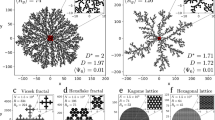Abstract
THE gas clouds of the interstellar medium have a fractal structure, the origin of which has generally been thought to lie in turbulence1,2. The energy of turbulence could come from galactic rotation at large scale, then cascade down to be dissipated on small scales by viscosity5,14; it has been suggested that such turbulence helps to prevent massive molecular clouds from collapsing in response to their own gravity15,16. Here we show that, on the contrary, self-gravity itself may be the dominant factor in making clouds fractal. We develop a field-theory approach to the structure of clouds, assuming them to be isothermal, and with only gravitational interactions; we find that the observed fractal dimension of the clouds arises naturally from this approach. Although this result does not imply that turbulence is not important, it does demonstrate that the fractal structure can be understood without it.
This is a preview of subscription content, access via your institution
Access options
Subscribe to this journal
Receive 51 print issues and online access
$199.00 per year
only $3.90 per issue
Buy this article
- Purchase on Springer Link
- Instant access to full article PDF
Prices may be subject to local taxes which are calculated during checkout
Similar content being viewed by others
References
Larson, R. B. Mon. Not. R. Astron. Soc. 194, 809–826 (1981).
Falgarone, E., Phillips, T. G. & Walker, C. K. Astrophys. J. 378, 186–201 (1991).
Scalo, J. M. in Instellar Processes (eds Hollenbach, D. J. & Thronson, H. A.) 349–392 (Reidel, Dordrecht, 1987).
Wilson, K. G. Rev. Mod. Phys. 55, 583–600 (1983).
Albeverio, S. & Høegh-Krohn, R. Commun. Math. Phys. 30, 171–200 (1973).
Hubbard, J. Phys. Rev. Lett. 3, 77–78 (1959).
Horwitz, G. & Katz, J. Astrophys. J. 222, 941–958 (1978).
Pfenniger, D. & Combes, F. Astron. Astrophys. 285, 94–118 (1994).
Domb, C. & Green, M. S. Phase transitions and Critical Phenomena Vol. 6 (Academic, New York, 1976).
Morris, T. R. Phys. Lett. B 334, 355–362 (1994).
Landau, L. D. & Lifshitz, E. M. Physique Statistique 4th edn (Mir-Ellipses, Paris, 1996).
Kleiner, S. C. & Dickman, R. L. Astrophys. J. 312, 837–847 (1987).
Pfenniger, D., Combes, F. & Martinet, L. Astron. Astrophys. 285, 79–93 (1994).
Fleck, R. C. Astrophys. J. 458, 739–741 (1996).
Henriksen, R. N. & Turner, B. E. Astrophys. J. 287, 200–207 (1984).
Chièze, J.-P. Astron. Astrophys. 171, 225–232 (1987).
Author information
Authors and Affiliations
Rights and permissions
About this article
Cite this article
de Vega, H., Sánchez, N. & Combes, F. Self-gravity as an explanation of the fractal structure of the interstellar medium. Nature 383, 56–58 (1996). https://doi.org/10.1038/383056a0
Received:
Accepted:
Issue Date:
DOI: https://doi.org/10.1038/383056a0
Comments
By submitting a comment you agree to abide by our Terms and Community Guidelines. If you find something abusive or that does not comply with our terms or guidelines please flag it as inappropriate.



